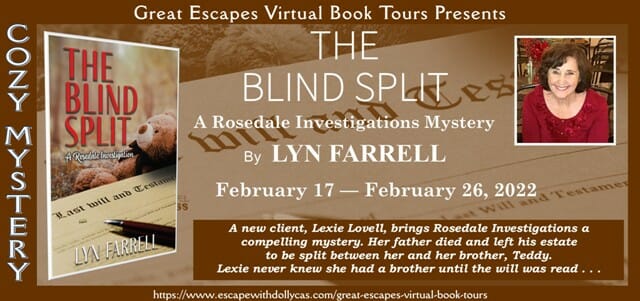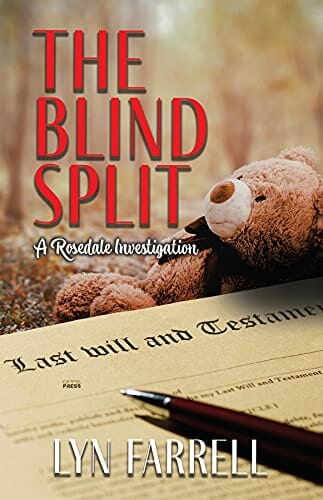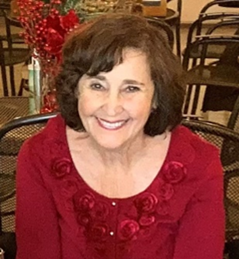

Lyn Farrell also writes as Lia Farrell. She decided to become a writer in the seventh grade. The Blind Split is the second installment in the Rosedale Investigations mystery series.
Personal stories find their way into fiction
“I get ideas from everyone I meet,” Lyn said. “I try to do justice to their experiences by fictionalizing their stories. I once met a young woman who discovered she had a brother by finding a photo of a child holding a teddy bear. She recognized the bear as one identical to one she had as a child. The photo was of a brother she never knew she had. Unlike Lexie in my story, the woman never wanted to meet this brother.”
Lyn also described the story of a friend whose daughter was very ill as a young child. “She wasn’t coming around and the doctor in that case approved bringing her dog to the hospital. Seeing the dog helped enormously in her recovery. A middle-aged woman I knew served a Thanksgiving dinner for her family. A few hours after dinner, the husband of the woman asked his sons, ‘Where is your mother?’ They didn’t know, but after a search of the house and calling all the neighbors and friends, they walked down to a large dumpster in the complex and found a pool of blood.
“They organized a search and people were out until 3:00 a.m. It was very cold, and they knew the woman hadn’t taken her coat. Ultimately, she was found, having been taken to the hospital by a Good Samaritan who found her walking by a road. When her husband came to get her and asked, ‘Sweetheart, what the heck happened?’ she answered, ‘Who are you?’ Unlike Pansy in my story, that woman recovered from her amnesia.”
Moral challenges arise in The Blind Split

“My characters are often faced with moral challenges. In this case, Lexie is furious with her father for leaving her mother, getting a new woman in his life and then having a child with her. Since I like my characters and want them to do the right things, I had Lexie forgive her father. Later on in the story, when little Teddy is rescued, I realized he needed a family. His mother was in a coma, and his aunt was in jail. I had my character, Dory, track down the child’s grandmother, and got the aunt paroled.”
On a personal level
“I always wanted to be a writer, but was unable to write until I retired. Shortly thereafter, I was outside walking my dog on an icy day and fell, breaking my arm. I went to visit my daughter, Lisa, in Tennessee, because I couldn’t drive or cook. While there, we read a newspaper article about her road. It was curvy and several accidents had occurred. The Road Commissioner wanted to straighten it, and a neighbor of my daughter’s wanted to prevent the action. When I read the article, I told my daughter if it was a mystery, somebody would bump the woman off.”
The two became a writing duo and penned six books in the Mae December series. “After that, my daughter decided she didn’t want to write any more. I then set out solo to write the Rosedale Investigations series. I am the mother of 2 daughters, the step-mother of six, and the grandmother of 12. Because of the love I had for my grandmother, I always try to be the best grandmother possible. I am a great animal lover and dogs always find their way into my books. I am also drawn to art because I had a grandfather who was a famous illustrator. My upcoming book is all about a painting that is cursed.”
Sticking to the story despite the complex details
The Blind Split contains a complex series of medical events. Lyn is fortunate in that she has a son-in-law who is a physician. “He helps me, but I still struggle with how much clinical detail to put in the story. In this case, one of the things that came up was how to describe the near-comatose state of Pansy Delaney. Sometimes I described it as a coma, sometimes as a state of confusion that was not resolving. I don’t want the clinical case to take over the story, but put in just enough to make it plausible without surrendering the story to the medical details.”
Lyn has also had some personal experience in discovering medical details. She once snuck into the Gross Anatomy Lab of the medical school where she worked. And the results were not what she expected. “The corpses that are dissected by medical students were laying out on the tables. I had envisioned dead bodies being the same color as living bodies, but these had been treated by formaldehyde, a scent which hung heavily in the air, and all of them were the same color, a deep russet.”
Learn more about Lyn Farrell at www.lynfarrell.com. Did you like this interview? If so, click here to read more Behind the Story interviews from your favorite authors.
a Rafflecopter giveaway